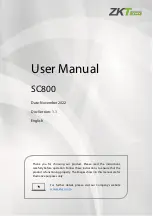
26 LCD CONTROLLER (LCDC)
26-44
Seiko Epson Corporation
S1C33L26 TECHNICAL MANUAL
Writing 1 to LUTRLD resets the look-up table entries with the reload table data. This reload operation
should be performed during a vertical non-display period. LUTRLD retains 1 during reloading and it
reverts to 0 when the reloading is completed.
The LUT reload function is effective when the look-up table function is enabled (LUTPASS/LCDC_
DISPMOD register = 0).
In color mode, DSTRAM must be switched to LUTRAM before setting the look-up tables using the
LUT reload function.
If LUTRLD and CTABRLD are both set to 1 at the same time, the LCDC replace the control register
data first, then LUT data.
See Section 26.9 for the reload table contents.
D0
CTABRLD: Control Table Reload Trigger Bit
Replaces the LCDC control registers by the reload table data.
1 (W):
Trigger to reload
0 (W):
Ignored
1 (R):
Reloading
0 (R):
Reloading has finished (default)
Writing 1 to CTABRLD resets the control registers with the reload table data. This reload operation
should be performed during a vertical non-display period. CTABRLD retains 1 during reloading and it
reverts to 0 when the reloading is completed.
See Section 26.9 for the reload table contents.
LCDC Reload Table Base Address Register (LCDC_RLDADR)
Register name Address
Bit
Name
Function
Setting
Init. R/W
Remarks
LCDC Reload
Table Base Ad-
dress Register
(LCDC_
RLDADR)
0x302054
(32 bits)
D31–10 RTBL_
BADR[31:10]
Reload table base address
(1KB boundary address, A[9:0] =
0x0)
Areas 3
*
–5, 7–10, 13–16, and
19–22
0x0 R/W
*
DSTRAM cannot
be used.
D9–0 –
reserved
–
–
–
0 when being read.
D[31:10] RTBL_BADR[31:10]: Reload Table Base Address Bits
Specifies the reload table base address. (Default: 0x0)
A 1K-byte boundary address in IVRAM or an external memory must be specified.
Note: DSTRAM in Area 3 cannot be used to locate the reload table. For more information, see “Bus
Masters and Accessible Memories” in the “Memory Map” chapter.
D[9:0]
Reserved
















































